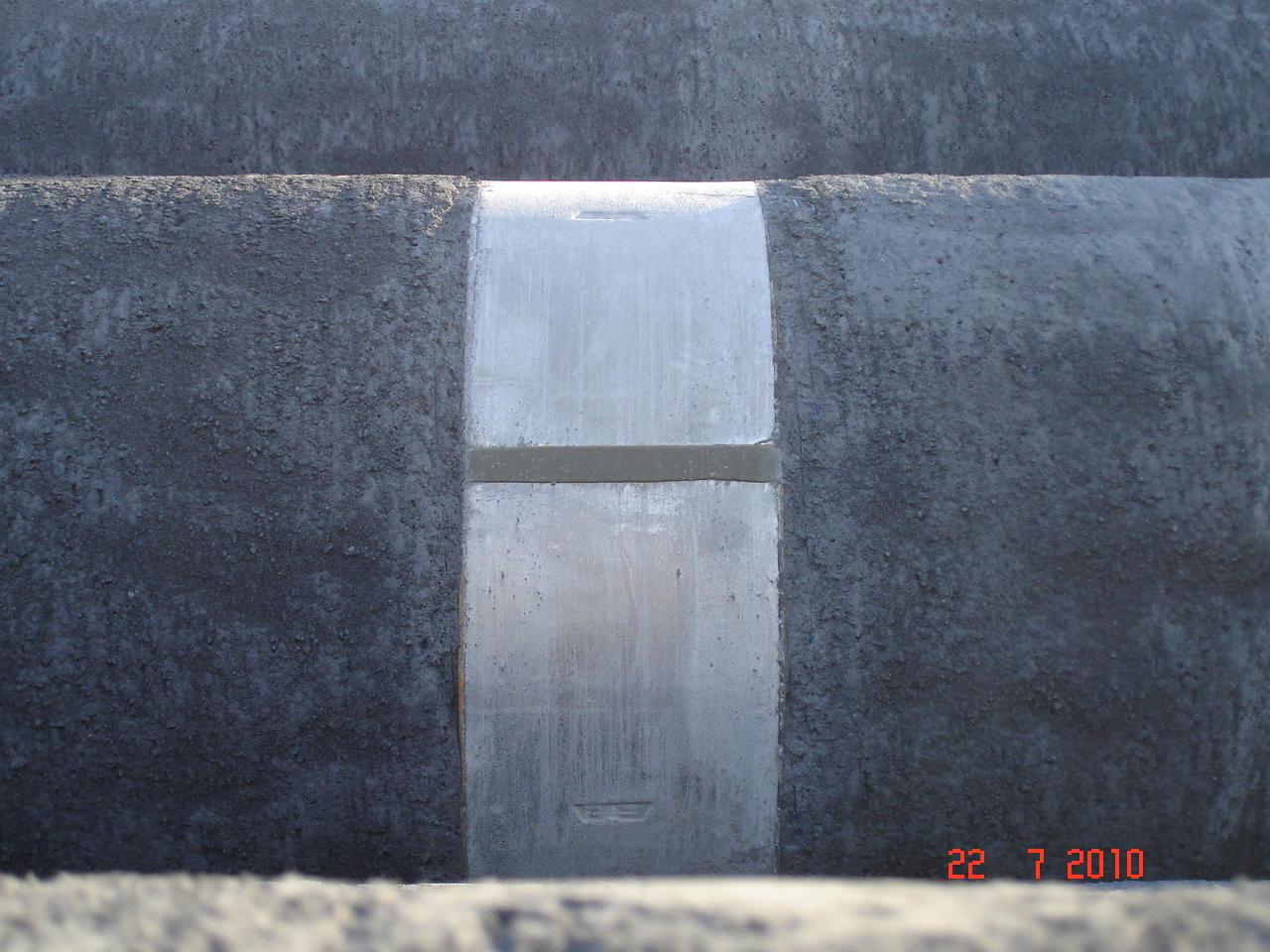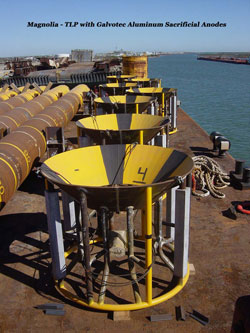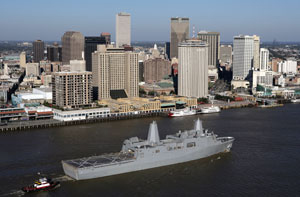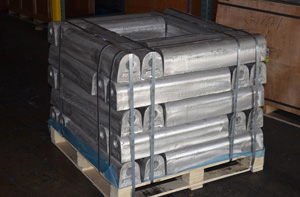- ANODES HomePage
- Aluminum Anodes
- Zinc Anodes
- Magnesium Anodes
- Extruded Magnesium Anodes
- Anodes for Wind Turbines
- Anodes for Solar Panel Farms
- Corrosion Services
- Anode Catalogs
- About Galvotec
- Did you know...
- Contact Us
- Anode Links
- Site Map
![]()
Click here to view our
newest brochure

Certificate Number: 3612.01
click here to view our ISO/IEC
ISO/IEC 17025:2017 A2LA Laboratory
Accreditation Certificate
OTHER GALVOTEC
COMPANIES WEBSITES
Did you know...
 Did you know that Galvotec produced some of the Worlds Largest and Heaviest Aluminum Bracelet Anodes ever manufactured?
Did you know that Galvotec produced some of the Worlds Largest and Heaviest Aluminum Bracelet Anodes ever manufactured?
The Amoco Trinidad project with Anodes that were 40 ½ in Diameter and 2 ½ thick. Each Anode weighed over 1100 Lbs.

Did you know that Galvotec Aluminum Anodes protect the first platform project completed by Shell's Deepwater Services Group?

Shell Exploration & Production Company has begun oil and gas production from its 100 percent-owned Brutus tension leg platform (TLP) located in Green Canyon Block 158 in 2,985 feet of water in the Gulf of Mexico. Brutus, an eight-slot TLP, is Shell's first deepwater platform to be specifically designed to serve as a hub for future subsea developments in the surrounding area, although several Shell platforms have been previously retrofitted to serve as hubs. Brutus is Shell's fifth TLP in the Gulf of Mexico.
The Brutus project is also the first major platform project completed by Shell's deepwater services group. The services group was established in 1999 to better leverage Shell's global expertise to reduce cycle time and costs in the construction of major deepwater projects around the world.
"With the completion of Brutus, we have proven that the concept surrounding the development of an internal center of excellence in deepwater project execution is a valid one," commented Matthias Bichsel, director, Deepwater Services, Shell International Exploration and Production Inc. "Working seamlessly with the SEPCo staff, we developed and executed a plan that completed the Brutus project seven months earlier than the previous best completion time and 18 percent below our cost benchmark, which was the Ram Powell project. This type of excellent performance is already being shared with Shell operating units globally."
Shell's Deepwater Services was responsible for design, construction and installation of the TLP system and pipelines, while SEPCo is responsible for subsurface evaluation and management, drilling, completion and production operations.
Although viable as a stand-alone project, the Brutus field will not be theonly oil and gas development utilizing the platform for processing. "Designing the Brutus platform to accommodate future production from surrounding areas continues Shell's successful strategy of establishing and leveraging significant infrastructure points in the deepwater Gulf of Mexico," said Raoul Restucci, president and CEO of Shell Exploration & Production Company. "Having a strong infrastructure creates an economic and competitive advantage and minimizes the environmental footprint of future operations. "I am extremely pleased with the Brutus project," continued Restucci. "It is an outstanding example of delivering on our promises. We are proud of the accomplishments of the project and operations staff in delivering the project to production in record time with excellent cost performance."
Production began on Aug. 3, 2001, and is continuing to ramp up. The average daily production rate currently is about 25,000 barrels of oil and 35 million cubic feet of gas from the first well. A peak daily production rate of 100,000 barrels of oil and 150 million cubic feet of gas from the Brutus field is anticipated to occur by the second quarter 2002. Gross ultimate recovery is estimated at about 250 million barrels of oil equivalent.
The Brutus tension leg platform is located approximately 165 miles southwest of New Orleans. The TLP is 3,250 feet high, from the seafloor to the crown block of the drilling rig. Although similar in size and configuration to Shell's Mars and Ram Powell TLPs, Brutus was designed with increased displacement to handle subsea tiebacks and with dual processing systems for its role as a hub.
Did you know that Galvotec Anodes protect the World's first production Spar being used as a base for well production operations located just 135 miles southeast of New Orleans in The Gulf of Mexico?

Oryx's Neptune field is located in Viosca Knoll block 826, approximately 135 miles south-east of New Orleans, in the Gulf of Mexico. The water depth ranges from 1175ft in the north-west corner of block 825, to 3,225ft in the south-east corner of block 870. To develop the field, Oryx used the world's first production spar as a base for well-production operations.
Oryx contracted Deep Offshore Technology (DOT) and their consortium members, J Ray McDermott, as the installation and topsides contractors and Aker Rauma Offshore, for the design and fabrication of the hull and mooring system.
The spar supports a three-level integrated deck above the top of the hull, consisting of a clear workover deck, a mezzanine production deck and a main production deck. Deck elevations are 116ft, 93ft and 71ft, respectively. A two-stage, three-phase separation system is used to produce the wellstream. Platform power is provided by three turbine generator sets, each rated at 900kW. The wells, pre-drilled with a semisubmersible, will be completed with a 1000hp portable platform workover rig, placed temporarily on the spar. The wellheads are located in the centrewell, between the workover deck and the production deck levels.
The spar hull of the Neptune was fabricated in 17 sections at the M�ntyluoto Works indoor assembly hall in Pori, Finland. It is essentially a 72ft-diameter cylinder, which is 705ft long with a draft of 650ft. It weighs 12,895t. A 32ftx32ft� centrewell inside the hull accommodates 16 buoyancy-supported risers, grouped in four rows of four.
Buoyancy tanks extend from the cellar deck to the bottom of the variable ballast tanks, 220ft below the waterline. It is subdivided by four vertical radial bulkheads and horizontal decks into smaller watertight compartments.
The oil is exported by six oil transfer pumps, each rated at 6,000b/d. Its two compressors can deliver 30 million ft�/day gas, at 1700psi, to the pipeline. The oil and gas are exported by separate 8in lines, 17.5km to the north, to the CNG new fixed platform on Main Pass block 225.
On the sea floor, the wells are arranged in two parallel rows, which are 105ft long and separated by 20ft, so that the wells are spaced 15ft apart in one direction and 20ft in the other. By adjusting the mooring lines, the spar can be positioned so that the riser is between the rows, while the riser is being run.
The spar is held in position by a six-line mooring. Securing each mooring leg to the seafloor is an 84in-diameter by 180ft-long pile. This is connected to 220ft of 4,3/4in chain, 2,400ft of 4,3/4in jacketed spiral-strand steel rope and 1,050ft of 4,3/4in chain, leading through a fairlead, to a chain jack at the spar's deck. Breaking strengths for the 4,3/4in wire and 4,3/4in chain are 2,750kips and 2,846kips, respectively.
The hull was transported as two sections, 390ft and 315ft in length, on-board the heavy-lift vessel Mighty Servant III. They were floated together and aligned, before the final girth seam weld was completed by Litton Ingalls Shipbuilding.
After the spar hull was upended, the pre-installed mooring lines and export pipelines were lifted from the seafloor and attached to the spar hull, using a specially designed installation-winch system. The production deck was then transported offshore on a 300mx90mx20m material barge. The lift weight of the production deck was 3,200t. The lift used for this was a typical four-point lift, utilising 12in x 92ft slings.
Did you know that Galvotec Sacrificial Anodes were selected to protect the Nord Stream pipeline project?
Click Here to get more information.


Did you know that Galvotec Aluminum and Zinc Sacrificial Anodes are protecting an FPSO that weights over 300,000 tons?

Shell Bonga deepwater oil and gas field is located 120 kilometers offshore Nigeria. The production facilities comprise one of the world�s largest Floating Production Storage and Offloading (FPSO) vessels. The FPSO has a storage capacity of two million barrels.
Shell Bonga weights in at 300,000 ton. The hull was built in South Korea by Samsung Heavy Industries.
 The Magnolia offshore oil drilling and production Extended Tension Leg Platform is located in the Gulf of Mexico. The ETLP reaches 1,432 m (4,698 ft.) The design capacity is an estimated daily production of 50,000 bbl (7,9000 m3) of oil and 150,000,000 cu ft (4,200,000 m3) of natural gas.
The Magnolia offshore oil drilling and production Extended Tension Leg Platform is located in the Gulf of Mexico. The ETLP reaches 1,432 m (4,698 ft.) The design capacity is an estimated daily production of 50,000 bbl (7,9000 m3) of oil and 150,000,000 cu ft (4,200,000 m3) of natural gas.

First U.S. built deepwater dry tree drilling and production hull.
The MinDOC platform is installed in 4,000 ft of water to service the Telemark Hub in the Gulf of Mexico.
The MinDOC is a light weight, cost effective design that looks like a semisubmersible but behaves like a spar in terms of stability and dynamic response to wave action. The platform supports full drilling capability, and a processing capacity of 25,000 b/d of oil and 50 MMcf/d of natural gas, with expansion to 100 MMcf/d of natural gas.
Did You Know That Galvotec Produces Pipeline Bracelet Anodes?
Pipeline bracelet anodes are specifically designed to protect subsea pipelines.
Galvotec manufactures bracelet anodes that are made for use on all types of pipelines including concrete coated.
Pipeline anodes are available in several configurations including bolt-on, weld-on, and flat end or tapered end.
A large variety of sizes and weights are available for pipelines as small as 1" to over 48" in diameter.
All anode dimensions such as thickness, length, and gap can be modified by mold design to accommodate your specific requirements.
Bracelet anodes are typically manufactured of either aluminum or zinc anode alloys.
Galvotec specializes in manufacturing to the most challenging bracelet anode designs.
 Did you know that Galvotec can produce any type of Platform Anode imaginable?
Did you know that Galvotec can produce any type of Platform Anode imaginable?
Galvotec has been manufacturing Platform Anodes for all of the major oil companies around the world since 1984. Galvotec is the oldest and largest anode foundry in North America.

Did you know that Galvotec Anodes protect the $1.3 billion USS New Orleans?

NEW ORLEANS (NNS) -- Sailors from USS New Orleans (LPD 18) and Marines from the 14th Regiment manned the rails of the San Antonio class ship March 10, bringing it to life during a commissioning ceremony in the ship's namesake city.
The celebration of the first ship to be built and commissioned in her namesake city began with a 19 gun salute. The ship is the fourth ship to bear the name New Orleans and is the second ship to be commissioned in its class.
Honored guests addressed ship's company, family members, and citizens of the "Crescent City."
 New Orleans mayor, Ray Nagin, spoke about the strong connection the ship and the city share.
New Orleans mayor, Ray Nagin, spoke about the strong connection the ship and the city share.
"I believe the ship and the city have a lot in common. We both survived Hurricane Katrina and we have both rebuilt after the storm," said Nagin. "Those experiences have endowed us with dignity, and today we both stand as examples of America's perseverance and faith."
The ship's commanding officer, Cmdr. John B. (Brad) Skillman, agreed that the ship has strong ties to the city where she was built, christened, and commissioned.
"This ship truly belongs to the city of New Orleans, never more so than after the hurricane," said Skillman. "[The ship] survived a CAT 5 hurricane because the ship's system design built to protect her worked."
Adm. Gary Roughead, Commander, U.S. Pacific Fleet, not only noted the ship's ability to withstand the storm, but also looked forward to what the ship and its crew will accomplish in the fleet.
"We expect much from a ship that comes alive today with the spirit of New Orleans, the pride and confidence of the builders and the plank owners," said Roughead. "For more than 150 years U.S Navy ships and Sailors and Marines have played a vital role in the Navy Pacific region in war and in peace.
The ship is scheduled to get underway March 12, and will ultimately sail to join the Pacific Fleet in its home port of San Diego.
Skillman assured the city of New Orleans his crew is capable and ready to fulfill its role in the Pacific Fleet and U.S. naval history.
"The crew is ready to take this ship to sea. I have never been so fortunate to serve with so many fine Sailors in my time of service," said Skillman. "Have no worries about the future of the United States if these young men and woman are the representative of what we can produce. You can trust us with your name, your spirit and your ship.
Did You Know That Galvotec Produces Hull Anodes?
Hull Anodes are specifically designed for the cathodic protection of hulls for ships and other types of vessels.
Galvotec manufactures most of the common commercial hull anodes available. We can also custom fabricated just about any hull anode to your specific requirements.
Galvotec Hull Anodes meet or exceed the following Mil-Spec Requirements
- Mil-A-18001K (or latest edition) (aka: ASTM B-418 Type I) for Zinc Hull Anodes
- Mil-A-24779 (Ships) for Aluminum Hull Anodes
- Mil-A-21412A (Ships) for Magnesium Anodes
Click here to view or print the brochure/anode catalog pages for Galvotec Aluminum Hull Anodes
Click here to view or print the brochure/anode catalog pages for Galvotec Zinc Hull Anodes
Click here to view or print the brochure/anode catalog pages for Galvotec Magnesium Hull Anodes
All Hull Anodes are available with or without Plastisol coating
Typical Anode core configurations are manufactured for Bolt-On or Weld-On Applications.

Aluminum Anodes

Zinc Anodes

Magnesium Anodes
Our experience in producing galvanic anodes assures that you will receive top quality anodes that will effectively inhibit corrosion when used in a properly designed and maintained cathodic protection system.
